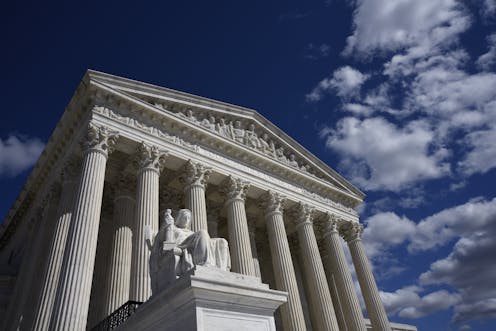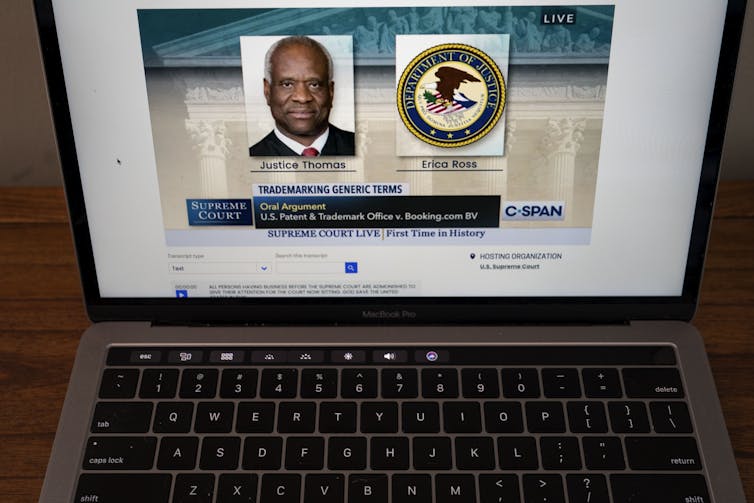
When the Supreme Court began livestreaming audio of oral arguments in May 2020, it was because the COVID-19 pandemic prevented the justices from convening in person.
But since then, even as pandemic-era restrictions eased, the Supreme Court has continued livestreaming, uninterrupted. The Supreme Court initially approved the practice on a month-by-month basis, then three months at a time, and most recently for an entire term, stretching from October 2022 through April 2023, when it last met to hear arguments.
But the Supreme Court has not announced whether it will continue livestreaming beyond its 2022 term, which ends in June 2023.
Reactions to livestreaming
The practice has become popular among legal observers, media and some members of the general public.
When the Supreme Court heard oral arguments in Dobbs v. Jackson Women’s Health Organization, which considered the federal right to get an abortion, hundreds of thousands of people tuned in remotely in December 2021 to listen to the deliberations.
News media outlets also provided commentary in real time during oral arguments, which are the only public portion of the Supreme Court’s decision-making process.
While the Supreme Court publishes written opinions explaining its rulings, most of its work takes place behind closed doors.
Before May 2020, people could attend oral argument sessions in person, but the courtroom only has seating for about 50 public observers. In contrast, livestreamed audio allows anyone interested to hear the Supreme Court at work in real time.
We are scholars of the U.S. Supreme Court. Our 2023 book, “SCOTUS and COVID: How the Media Reacted to the Livestreaming of Supreme Court Oral Arguments,” examines whether news media coverage of the oral arguments changed after the Supreme Court began to livestream its proceedings.

Does livestreaming change news coverage?
Our research shows that news media coverage before and after livestreaming looks very similar.
Reporting on the Supreme Court is vital to the public, which relies on news coverage to understand decisions on abortion rights, affirmative action, voting rights and student loan forgiveness.
News outlets’ decisions about what part of the oral arguments they cover, for example, may help shape public perceptions of the Supreme Court and justices’ decisions.
The number of news stories about a particular case – as well as the length of those stories and the use of direct quotes from justices or attorneys – spiked when livestreaming first started in May 2020. But the increase was temporary.
The only substantial, long-term change we detected after the Supreme Court began livestreaming is the use of embedded audio clips within news stories.
Including audio clips in news stories allows people to hear what justices and attorneys said as they discussed cases. But audio clips can only convey small slices of discussions.
Prior to livestreaming, the Supreme Court did not release oral argument audio in time for audio clips to be included in breaking news coverage.
When the Supreme Court opened the door to livestreaming, we also observed a short-term spike in the number of news stories containing oral argument audio clips of justices and attorneys speaking to one another. But it did not last.
In general, we have found that media outlets use audio clips sparingly, rather than as a core feature of a new type of reporting about the Supreme Court.

A temporary measure?
The public has expressed interest in the Supreme Court’s proceedings by tuning in by the hundreds and, in some cases, the thousands to listen to livestreamed audio in the last three years, particularly in controversial cases.
Lawyers, media outlets and members of Congress have asked the Supreme Court to make livestreaming a permanent fixture, noting benefits such as that this practice allows the public to “hear directly from the justices, unfiltered and in real time.”
Yet, despite the public interest, the Supreme Court has not committed to continuing livestreaming.
Some justices, including retired Justice Anthony Kennedy, have expressed concern that increased access, including via video cameras during oral arguments, would incentivize grandstanding by lawyers or justices and that “sound bites” taken out of context could compromise the Supreme Court’s legitimacy in the eyes of the public.
Kennedy also said he does not want the Supreme Court to become part of the national entertainment network.
Our findings indicate that increased access provided by livestreaming oral argument audio did not, on the whole, permanently alter news media coverage of the Supreme Court. This suggests that it is possible for the Supreme Court to remain more transparent without creating risks for misinterpretation.
Public access allows individuals to observe, know and understand how government institutions function. Such transparency promotes trust in, and the legitimacy of, such institutions.
Since oral arguments are the only public part of the Supreme Court’s work before a decision is announced, we think that access to these proceedings is a critical component of the Supreme Court’s transparency and, ultimately, its legitimacy as a coequal branch of the federal government.
The authors do not work for, consult, own shares in or receive funding from any company or organization that would benefit from this article, and have disclosed no relevant affiliations beyond their academic appointment.
This article was originally published on The Conversation. Read the original article.







